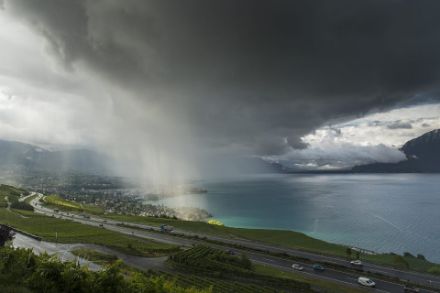Service Navigation
Search
Rain is the only form of precipitation. that occurs in liquid form. It is made of water droplets that generally fall to the Earth’s surface, although they do sometimes evaporate before reaching the ground. Rain is measured in millimetres (mm), whereby 1 mm of rain is equal to 1 litre of water per square meter. Rain and other types of precipitation are measured with a pluviometer every 10 minutes at the weather stations of the MeteoSwiss automatic monitoring network.

How rain forms
Rain is closely connected with the level of humidity, particularly at higher altitudes. Moist air can result in the formation of clouds, which consist of water droplets. At subzero temperatures, these droplets are supercooled, turning into ice crystals only when they encounter a freezing nucleus. The crystals then become larger as they absorb more and more droplets, thus forming snowflakes. When they become too heavy, they fall towards the Earth’s surface. If the temperature of the air they fall through is above freezing, then the snowflakes melt and become raindrops.
Record rainfall amounts
The warmer the air, the more water vapour it can contain. This is why thunderstorms, along with the heavy rain that accompanies them, develop in spring and summer. The record amounts of rainfall in 10 minutes and in an hour were both recorded during summer thunderstorms. The heaviest precipitation over several days usually occurs at the beginning of autumn on the southern side of the Alps, when the Mediterranean Sea, still warm from the summer, provides the right conditions, including a reservoir of moisture, for the formation of low-pressure areas.
Heavy rain warnings
If excessive rain is expected, Level 2 warnings are issued 5. The warning threshold varies depending on the region and the expected duration of the event. For the southern side of the Alps, where heavy rainfall occurs quite frequently, there are higher threshold values. If warnings are issued for heavy rain, heavy snowfall or severe thunderstorms, it is important to follow the recommendations for action.